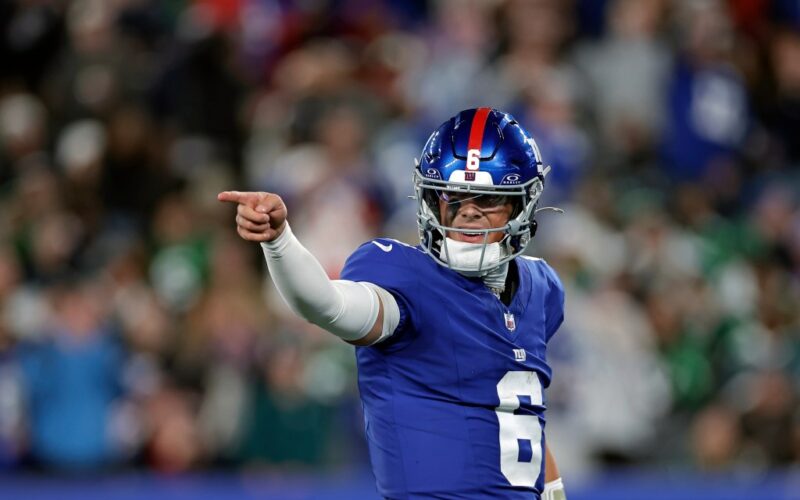If the Giants‘ offense has looked familiar the last three weeks, that’s because you’ve seen a lot of it before.
At Ole Miss.
The three-level route concepts, run-pass options, up-tempo operation and crossing routes prevalent in the Giants’ offense the last three weeks were installed on purpose.
Brian Daboll couldn’t start Jaxson Dart in Week 4 without tearing up parts of Russell Wilson’s playbook to fit the scheme to his rookie quarterback’s strengths and make him most comfortable.
That meant giving Dart ownership of what the Giants’ evolved offense would look like. And it’s clear from watching the film that Dart pulled from his past and mixed in some of Lane Kiffin’s SEC offense with Daboll and offensive coordinator Mike Kafka’s foundational plan.
“I’m very vocal on the things that I feel comfortable with,” Dart said Wednesday. “Then at the same time, I’m very open-minded to trying new things, as well.”
Dart’s 35-yard touchdown pass to Wan’Dale Robinson in the first quarter of the Giants’ upset win over the Philadelphia Eagles is a good example of Dart bringing some of his college concepts straight to the pros.
On the play, Robinson and tight end Theo Johnson ran same-side crossing routes on the right side of the formation. Johnson continued running an over route to the left. Robinson turned outside to the right.
By the time Dart stepped up in the pocket and scrambled out to his right, he had three receivers at three different levels on the right side of the field: running back Devin Singletary in the flat, Robinson on the outside and Lil’ Jordan Humphrey on a deep post.
He hit Robinson with a completion. Robinson broke a tackle attempt by Eagles safety Andrew Mukuba, and the Giants had six points.
Giants receiver Juice Wells Jr., Dart’s college teammate at Ole Miss, re-signed to the practice squad this week. And he noticed some refreshingly familiar concepts immediately once he stepped back into practice on Wednesday.
“So I came back,” Wells said, “and we did install one for the Denver Broncos and all that stuff, and I’m looking back at plays, I’m like, ‘Wait, we just ran this play at’ — I’m not gonna tell you the calls — but there were certain concepts. I’m like, ‘Bro, that’s the same thing.’
“Of course it’s different names and stuff, but now that I see Dart’s the starting quarterback you can see some of the familiar concepts from Ole Miss starting to pop up,” he added.
None of this gives away what the Giants are doing on a down-to-down basis. Most offenses share a lot of the same concepts. Teams just add their own wrinkles and give different names to similar versions of the same play.
Dart’s mobility is the X-factor that makes all of this go anyway. No matter what play Kafka calls, a lot of Dart’s success has been due to improvisation with his legs. Sometimes it’s designed. A lot of times it’s the quarterback making a play on his own.
“He can make every throw across the field,” Broncos corner Pat Surtain II, the reigning NFL Defensive Player of the Year, said this week. “A very underrated part of his game is his scrambling ability and his ability to create second-chance opportunities for his offense on his feet. You saw it last week against Philly. He had a few possessions where he made plays [with] his feet. That is something we will have to take account for.”
The influence of Kiffin’s Ole Miss scheme still is unmistakable in the Giants’ new offense, and it actually fits pretty seamlessly with what Kafka already did well: stretching the field horizontally as well as vertically.
“The offense that we put in [for Dart] is our core offense,” Kafka said Thursday. “There are certain things that you want to do to accentuate certain players from the skill position group, from the O-line group. Then some things that you want to carry over that the quarterback has really good comfort in.”
One consistent theme is using the run-pass option (RPO) game, toss action, play action or motion to stretch the defense wide and open the middle or take shots downfield. Dart hit Johnson, his tight end, for a 22-yard gain on 3rd and 8 late in the third quarter on just such a play.
Running back Tyrone Tracy Jr. ran in motion in the backfield pre-snap from left to right, forcing Eagles linebacker Zach Baun to strafe outside. Tight end Daniel Bellinger stayed underneath out of the right slot. And Johnson pushed a sail route up the middle of the field and to the right past Mukuba.
When Johnson caught the ball, there it was again: the three routes layered on the same right side with Tracy in the flat, Johnson in the mid-range and Humphrey deep. And with two tight ends starting on the same side, Tracy was a threat for a screen pass on the outside that the Eagles’ Baun had to honor.
Wells described Ole Miss’ offense as simply: “Get your players open, let them run with the ball. Get your players catch and run, get them in space.”
“Coach Kiffin’s offense,” Wells said, “he’s taking advantage of the weaker DB [defensive back] or the DB he feels like is not the primary DB, trying to go at him, and [using] different concepts to get guys open and guys around the edges, whether it’s a fast guy on a sweep, stuff like that. And he’s gonna throw the ball deep.”
Wells’ re-signing is more evidence of Dart’s influence on the offense and plan. The quarterback all but confirmed he made the suggestion to bring Wells back, and Daboll and Schoen listened. As they should have. If they’re embracing the Ole Miss offense’s concepts, they might as well bring back a receiver who knows that playbook better than most.
“First of all, it’s just cool to be in an organization where everybody can cooperate and communicate with one another,” Dart said. “That’s something that I’m really thankful for, just being here. So, me and [Daboll] have conversations all day, every day, about kind of how he sees things, how I see things. There’s definitely a lot of communication.”
Wells, who was released by the Giants on cutdown day in late August, spent the last month training in Tampa, Fla., with strength coach Yo Murphy. He didn’t know if Dart was the primary reason for his return, but he did stay in touch with Dart and Cam Skattebo while cheering the Giants from afar.
“Honestly, I don’t know,” Wells said. “But I was texting him during the time after a good game like, ‘Let’s go, bro. Good job.’ Texting Skatt, ‘Let’s go.’ I was too hype. While I was gone, the Giants were my favorite team. I was watching them boys like a hawk, watching all the plays trying to figure out what plays they were running because I was just with them. I didn’t want to be anywhere else honestly. I was still locked in.”
Wells had told the Daily News during the preseason that Dart was about to take the NFL by storm, so he’s not surprised at all to see the QB’s success.
“I knew he was gonna take off and he was gonna be ready,” Wells said. “What gave it that spark was that opening drive [against the Chargers], him just driving it down there and scoring with all that swagger. I’m like, ‘That’s the Dart I know.’ The way he’s taking over the team and being a leader, the future is so bright for him. I can’t wait.”
Forget the future. The present has been bright. Dart and the Giants have scored a touchdown on the first offensive drive of all three of his starts, and they’re on a two-game streak of scoring back-to-back TDs on their first two possessions.
The question now, then, is what can stop the Giants’ new offensive scheme with this strong Ole Miss influence?
The Denver Broncos, who lead the NFL with 30 sacks, might have the answer: pressure.
Blitzes and better pass rushes from Broncos defensive coordinator Vance Joseph’s front could clog the gaps that Dart likes to escape through with his scrambles. And the Giants’ use of misdirection on play designs takes time that Dart might not have in this matchup.
Just look like Jets quarterback Justin Fields’ 31 measly rushing yards on seven carries in last week’s loss to Denver in London.
“One of things the Broncos do very well with their pass rush is that they are disciplined in their rush lanes,” former NFL wide receiver Bennie Fowler said on the Talkin’ Ball with Pat Leonard podcast. “They don’t create a lot of rush lanes for quarterbacks to step up into and take off.
“Justin Fields has always been able to keep the play alive because of the way he scrambles,” Fowler continued. “But because of the Broncos and their pass rush attack and staying disciplined in those rush lanes, he was not able to extend any plays and run for first downs. And I think you’ll see something similar this week with Vance confusing Jaxson with different looks, forcing him to hold the ball or stay within that pocket.”
Fowler, a member of the Super Bowl 50 Broncos team that will be honored at Denver’s alumni game on Sunday, said Joseph might not even send many extra defenders to generate the pressure.
“It might not be a whole bunch of blitzes,” Fowler said. “It might just be, ‘Hey, we’re gonna stay right here in front of you, and we’re gonna force you to actually read this defense and throw the ball into coverage.’ And the Broncos have been playing extremely great coverage this year.”
Dart, Daboll and Kafka inevitably will try to answer that defensive plan with a strong running game headed by Skattebo and by attacking the boundaries with tunnel and bubble screens in the passing game.
Because that’s what Dart would have done in college. That’s where he’s comfortable. And whatever he likes is what the Giants are running.
“I think that I’m just trying to play efficient, play comfortable and just try to be as efficient as I can within the offense,” Dart said.
Within the Giants’ offense. Dart’s offense.
THREE MORE GIANTS JOIN INJURY REPORT
Wide receiver Darius Slayton (hamstring) and center John Michael-Schmitz (concussion) continued to sit out practice on Thursday. Both are likely to miss Sunday’s game at Denver. Linebackers Demetrius Flannigan-Fowles (hamstring) and Swayze Bozeman (ankle) remain out. Defensive lineman Chauncey Golston (neck) was downgraded from limited to out of practice.
Defensive linemen D.J. Davidson (knee) also did not practice Thursday after participating on Wednesday. And corner Paulson Adebo (shoulder) and safety Dane Belton (neck) joined the injury report as limited alongside right tackle Jermaine Eluemunor (shoulder/back), wide receiver Jalin Hyatt (ankle) and defensive lineman Roy Robertson-Harris (knee).
Corner Deonte Banks (personal reasons) was back at practice and participated fully. So did outside linebacker Victor Dimukeje (pec), who is on his way back from the physically unable to perform list.








